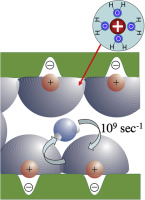Current Opinion in Colloid & Interface Science ( IF 7.9 ) Pub Date : 2019-10-18 , DOI: 10.1016/j.cocis.2019.10.001 Weifeng Lin , Jacob Klein

|
Hydration layers surrounding charges or zwitterionic moieties have long been known to play important roles in areas including antifouling and colloidal stability, and, particularly over the past 15 years or so, their role in boundary lubrication has been widely investigated. Hydration repulsion due to hydrated ions or polar groups present on surfaces may dominate their interactions at high electrolyte concentrations, so that Derjaguin-Landau-Verwey-Overbeek (DLVO) theory doesn’t apply. Hydration shells, strongly held by the charges they surround, can sustain large pressures without being squeezed out, while by rapidly relaxing they behave like a fluid during shear: this may lead to their acting as lubrication vectors with outstanding friction-reduction properties. This review considers hydration layers around trapped ions, polymer brushes, and amphiphiles (surfactants and phosphatidylcholines), focusing on their lubrication properties. Finally, we suggest some prospects for further development of current hydrated vectors and designing new hydrated vectors for modifying surface interactions.
中文翻译:

通过水合边界层控制表面力
长期以来,围绕电荷或两性离子部分的水合层在防污和胶体稳定性方面起着重要作用,尤其是在过去的15年左右,人们对它们在边界润滑中的作用进行了广泛的研究。表面上存在的水合离子或极性基团引起的水合排斥作用可能会在高电解质浓度下主导其相互作用,因此Derjaguin-Landau-Verwey-Overbeek(DLVO)理论不适用。水合壳被它们周围的电荷牢固地保持着,可以承受很大的压力而不会被挤压,而通过快速松弛,它们在剪切过程中的表现像流体:这可能导致它们充当具有出色减摩特性的润滑载体。这篇评论考虑了被困离子周围的水合层,聚合物刷,和两亲物(表面活性剂和磷脂酰胆碱),着重于它们的润滑性能。最后,我们为当前水合载体的进一步开发和设计用于修饰表面相互作用的新水合载体提出了一些前景。











































 京公网安备 11010802027423号
京公网安备 11010802027423号